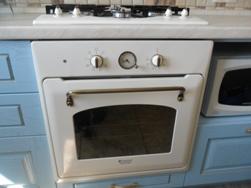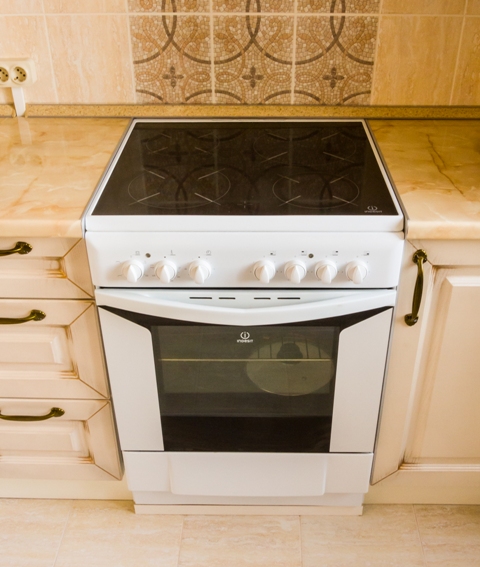Categories: Electrician at home, Electrical connection of equipment, Electric installation work
Number of views: 94769
Comments on the article: 31
Connection of an electric stove and a washing machine in the TN-C system
 The TN-C electrical grounding system has long been outlawed and banned for use. But it is easy to ban, but what about those whose homes were commissioned long before the introduction of new norms and rules?
The TN-C electrical grounding system has long been outlawed and banned for use. But it is easy to ban, but what about those whose homes were commissioned long before the introduction of new norms and rules?
Indeed, for the operating organization, the modernization of the common house wiring and bringing it at least to the TN-C-S system is an overwhelming waste of time, effort and money. And therefore, people living in old-built houses often face the challenge of incorporating modern household appliances into a two-wire network with a TN-C grounding system. And most of the questions arise when connecting powerful devices with a metal case.
The latter relates, first of all, to the electric stove and the washing machine. So, how do you enable these devices in your TN-C home network?
We connect an electric stove in TN-C
The sequence of actions is as follows:
1. Determine the location of the plate. The stove is considered a stationary electric receiver. Moreover, its power is relatively large. Therefore, to install the plate on the nearest wall, a special socket with an increased current rating (usually 32-40 amperes) with a grounding contact is mounted. For a three-phase network, the socket will contain 5 contacts, and for a single-phase network, three.
2. We install a separate circuit breaker of characteristic C in the apartment panel to power the stove. For a three-phase cooker and the same network, a three-pole circuit breaker with a value of about 16 amperes will be required, and for connecting a stove in single-phase mode, you need a single-pole circuit breaker with a rating of 25-32 amperes.
3. Mount the cable to connect the plate. For a single-phase plate it will be VVGng 3 * 4, and for a three-phase plate - VVGng 5 * 2.5, since in the latter case the current load will be less. Pull the cable from the apartment panel to the socket of the stove. We will talk about the methods of laying and installing the cable later.
4. Connect the cable to the outlet and close its cover. At this stage, you must be very careful. In order not to make mistakes and not to confuse ourselves, it is better to do everything in accordance with the standards: in a three-core cable we connect a brown core (it may turn out to be white) to the phase socket of the outlet, a blue core (white with a blue stripe) to the working zero connector , well, to the ground connector - a yellow-green core. In a five-core cable, phase conductors are usually white, red and brown.
The phase connectors of high-rated current sockets do not have any markings. The connector for the working neutral conductor is marked with the Latin letter N (neutral). The connector for protective grounding is marked with a special symbol “ground” (a vertical line perpendicular to the long horizontal, below which are horizontal parallel lines of shorter length in descending order).
Observe connector markings and color marking cable cores - Technically, it is not always a mandatory measure, except when the N connector is more powerful to absorb a greater current load.
5. Paying attention to the marking of the electrodes of the plug and observing the color marking of the cores, we connect the plug to the flexible cable of the electric stove. Here, everything is similar to connecting an outlet.
6. Connect the flexible cable of the plate to its rear panel. Much depends on the model of the plate and the number of phases in the network. We talked about this in detail in a previous article (How to independently connect an electric furnace and a washing machine) The ends of the flexible multi-wire cable, before installation in the terminal clamps, are preferably tinned to achieve reliable contact.Again, pay attention to the color coding of the cores and the marks on the terminals of the plate. Most electric stoves have a wiring diagram for single-phase and three-phase modes on their rear panel. Such a scheme can be of great help.
7. We cut the cable for connecting the stove in our apartment panel, we clean the ends. We connect the phase conductors to the pole clamps of the circuit breaker, and we "plant" the zero working core on a common bus where all the zero conductors are connected. Only one thing remains: what to do with the yellow-green vein? In the TN-S system, it connects to the ground bus. But what if we have a TN-C system?
Grounding plate in TN-C
Very often, even professional electricians when working in the TN-C system allow themselves such liberties: they ground the instrument case to a working zero bus. This is dangerous because when the working neutral conductor breaks, the "phase", passing through the load, will be on the "grounded" case, which will almost inevitably lead to electric shock.
In addition, a situation is possible when the electricians of the service organization confuse and interchange the zero working and phase conductors. In this case, when grounding to the working zero, we will not have Grounding and, if I may say so, "phase lock." The result may again be an electric shock at the most unexpected moment.
But to provide the body of the electric stove with protective grounding is still necessary. Otherwise, due to aging of the insulation of the internal conductors, the housing of this device may still acquire a dangerous electrical potential. Therefore, we take such actions:
1. You can find out if the housing of the electrical panel of your apartment has reliable grounding. Such information can be provided by the operating organization: Housing Office, Homeowners Association, etc. If they answer you in the affirmative and assure you that the shield body is grounded, then the yellow-green cable core can be safely connected through a bolt to this same housing. But if the case is not grounded, or if the employees of the operating organization cannot clearly answer your questions, then you should not "put" PE on the shield case. Such grounding can be ineffective or even dangerous for the reasons mentioned above.
2. If the apartment is located on the ground floor, then, as an option, you can consider installing your own, individual grounding device. The manufacture of this device is best entrusted to specialists, since it will require a work not only of electrical, but also of welding. A multi-wire wire in yellow-green insulation is removed from the apartment panel to the street, which is terminated by a tip. The cross section of the wire is chosen equal to the cross section of the phase supply conductors.
The grounding device itself is installed in the ground behind the external wall of the building, which usually consists of three steel bars with a length of at least 2.5 meters and a diameter of at least 16 mm. These bars are connected by a steel strip of 5 * 40 mm.
From a grounding device up to the level of the grounding conductor, a wire rod of 8 mm in diameter is output. The wire is terminated by a welded plate with a bolt hole. The wire rod is bolted to the grounding conductor from the apartment at a height of at least 2.5 meters from the ground.
In the apartment panel newly mounted ground wire sits on a separate zero bus, which becomes PE. To this bus and connect the grounding conductor from the electric stove.
Such a grounding system is already called TT and will cost a lot. The main thing is to remember that the resistance of the grounding device is strictly standardized and should not exceed 8 ohms for a single-phase network. It is unlikely that they will be able to measure this resistance on their own, so there is no way to do without hired labor.
3. Attempts to ground the electric stove on the pipes of cold water or even sewage, hot water or heating is better not to be made. Although these pipes must be grounded, no one actually controls the resistance of their grounding.Thus, it is possible not only to make an ineffective grounding, but also to harm your health or the health of neighbors. The same can be said about grounding from other utilities: ventilation shafts, elevator shafts, etc.
4. If nothing happens with grounding (the shield is not grounded, CT cannot be grounded), then we leave the yellow-green wire plugged in the shield until better times. In relation to the stove we take a number of actions.
We place the stove in such a place to exclude the possibility of simultaneous contact with its body and live parts that are not energized. We are talking about a metal mixer, sink for dishes and, of course, pipes of hot and cold water. Near the stove itself, it will be nice to provide a dielectric flooring. Of course, a dig in the kitchen is already too much, but an ordinary dry rug will not hurt.
In the absence of grounding, instead of a conventional circuit breaker, it is better to use a differential circuit with a tripping rating of 30 milliamps. Such a switch can save you when the leakage current from the stove body flows through your body (if this happens).
In any case, in the absence of grounding on the body of the electric stove, you must be extremely careful during its operation. If the stove is not in operation for some time, then it is better to completely turn it off from the power outlet.

We connect the washing machine in TN-C
Connecting a washing machine to the TN-C has only a few features. First of all, regardless of the possibility / impossibility of grounding the machine, you must connect it through a differential circuit breaker, since the washing machine is usually installed in the bathroom. And the bathroom is a room with increased danger. The differential switch, as in the case of the stove, is installed on an empty spot in the apartment panel. The required rating of the machine is 16 amperes, the differential tripping current is not more than 30 milliamps.
Three-phase household washing machines are not found in nature, therefore, to connect the “washer”, it is enough to install a regular 16 amp socket with curtains and a grounding contact. Cable connecting this outlet and difavtomat in the shield, it will be three-core - VVGng 3 * 2.5.
If it is not possible to ground the housing of the washing machine in the TN-C system, precautions against it are even more necessary than with respect to the hob. It is better to plug in such a washing machine only for the duration of its use. Moreover, during the operation of the machine, it is better not to take a shower and not to touch the body of this household appliance.
Alexander Molokov
We recommend reading:How to make the washing machine not shock
See also at e.imadeself.com
:
